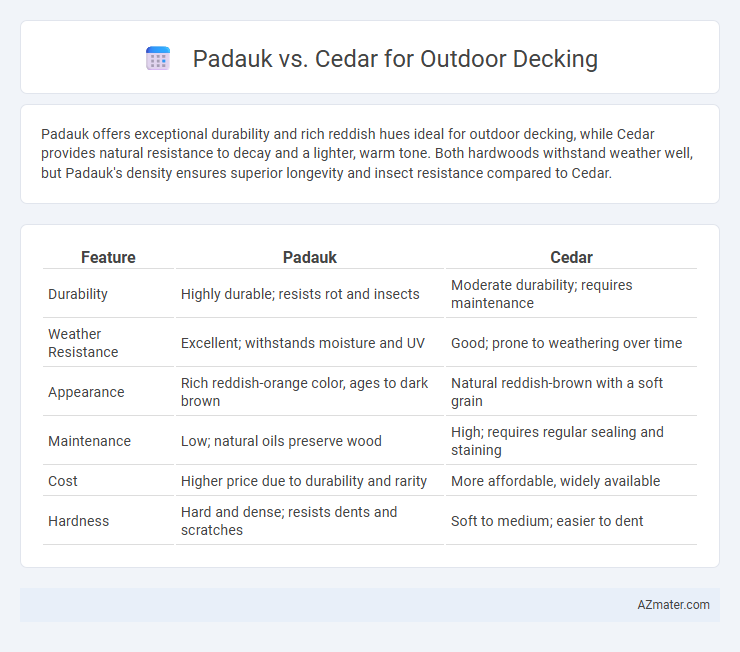Padauk offers exceptional durability and rich reddish hues ideal for outdoor decking, while Cedar provides natural resistance to decay and a lighter, warm tone. Both hardwoods withstand weather well, but Padauk's density ensures superior longevity and insect resistance compared to Cedar.
Table of Comparison
| Feature | Padauk | Cedar |
|---|---|---|
| Durability | Highly durable; resists rot and insects | Moderate durability; requires maintenance |
| Weather Resistance | Excellent; withstands moisture and UV | Good; prone to weathering over time |
| Appearance | Rich reddish-orange color, ages to dark brown | Natural reddish-brown with a soft grain |
| Maintenance | Low; natural oils preserve wood | High; requires regular sealing and staining |
| Cost | Higher price due to durability and rarity | More affordable, widely available |
| Hardness | Hard and dense; resists dents and scratches | Soft to medium; easier to dent |
Introduction: Padauk vs Cedar Outdoor Decking
Padauk and cedar are popular hardwood options for outdoor decking due to their durability and natural resistance to decay. Padauk features a vibrant reddish-orange hue with exceptional hardness and weather resistance, making it ideal for high-traffic areas. Cedar offers a more subdued, warm brown tone with natural oils that repel insects and moisture, providing a lightweight yet stable decking surface.
Wood Origin and Botanical Overview
Padauk, primarily sourced from Africa and Southeast Asia, belongs to the Pterocarpus genus known for its vibrant reddish-orange hue and dense, durable wood ideal for outdoor decking. Cedar, originating mainly from North America and the Mediterranean, is part of the Cedrus genus, valued for its aromatic qualities, natural insect resistance, and lightweight, stable structure. Both woods offer natural durability, but Padauk's tropical origin contributes to exceptional hardness and weather resistance, while Cedar's coniferous lineage provides superior dimensional stability and decay resistance in moderate climates.
Color and Aesthetic Differences
Padauk exhibits vibrant reddish-orange hues that deepen to rich mahogany over time, creating a bold and striking appearance for outdoor decking. Cedar offers a softer, more subdued palette with warm light browns and subtle reddish undertones, delivering a classic, natural rustic charm. The distinct color stability of Padauk resists fading better under sunlight, whereas cedar's patina matures gracefully, enhancing its traditional aesthetic appeal.
Durability and Weather Resistance
Padauk wood offers exceptional durability and natural resistance to rot, decay, and insect damage, making it ideal for outdoor decking in harsh weather conditions. Cedar, while moderately durable and resistant to moisture and insect attacks, typically requires regular maintenance and sealing to sustain its weather resistance over time. The dense grain and high oil content in Padauk enhance its longevity in outdoor environments compared to the softer, more porous structure of Cedar.
Maintenance Requirements
Padauk wood requires regular oiling and sealing to maintain its vibrant reddish hue and prevent weathering, while cedar naturally resists rot and insects with minimal treatment. Cedar decking benefits from occasional cleaning and reapplication of sealant to preserve its appearance and structural integrity. Both woods demand periodic maintenance, but Padauk's vibrant color necessitates more frequent upkeep to avoid fading.
Cost and Availability Comparison
Padauk offers a striking reddish hue and exceptional durability but comes with a higher price point and limited availability due to its tropical origin, impacting budget considerations for outdoor decking projects. Cedar is more commonly available in North American markets, providing a cost-effective option with moderate durability and natural resistance to decay, making it a popular choice for budget-conscious homeowners. While Padauk demands a premium investment and potential shipping costs, Cedar's widespread availability and lower price enhance its accessibility for large-scale decking installations.
Environmental Impact and Sustainability
Padauk wood, sourced primarily from tropical African and Southeast Asian forests, offers a durable option for outdoor decking with moderate sustainability concerns, as some species face deforestation pressures but can be sustainably managed through FSC-certified harvesting. Cedar, particularly Western Red Cedar, is known for its natural resistance to decay and pests, making it a long-lasting decking material with a lower environmental impact when sourced from responsibly managed North American forests. Both choices highlight the importance of certification standards such as FSC or PEFC to ensure environmentally responsible harvesting and support sustainable forestry practices.
Workability and Installation
Padauk offers excellent workability due to its fine grain and moderate hardness, making it easier to cut, shape, and fasten during decking installation. Cedar, known for its soft texture and lightweight properties, allows for smooth handling but may require pre-drilling to prevent splitting when screwing. Both woods provide dimensional stability, though Padauk's natural oils enhance resistance to decay, reducing maintenance challenges during outdoor decking installation.
Lifespan and Long-Term Performance
Padauk offers superior durability with a typical lifespan of 25 to 30 years, excelling in resistance to decay and insect damage, making it ideal for outdoor decking exposed to harsh weather. Cedar, while naturally resistant to rot and insects, generally lasts around 15 to 20 years and may require more frequent maintenance such as sealing or staining to preserve its longevity. Both woods perform well outdoors, but Padauk's denser grain and harder surface provide enhanced long-term stability and wear resistance compared to the softer, more porous structure of Cedar.
Final Recommendations and Best Uses
Padauk offers exceptional durability and vibrant reddish hues ideal for high-traffic outdoor decking in warm climates, resisting rot and insect damage effectively. Cedar provides natural resistance to decay and a more subtle, warm tone, making it suitable for shaded or less exposed areas where maintenance is easier and a softer aesthetic is preferred. For long-lasting, visually striking decks, Padauk is best, while Cedar excels in cost-effective projects requiring moderate durability and a classic, natural look.

Infographic: Padauk vs Cedar for Outdoor Decking
 azmater.com
azmater.com